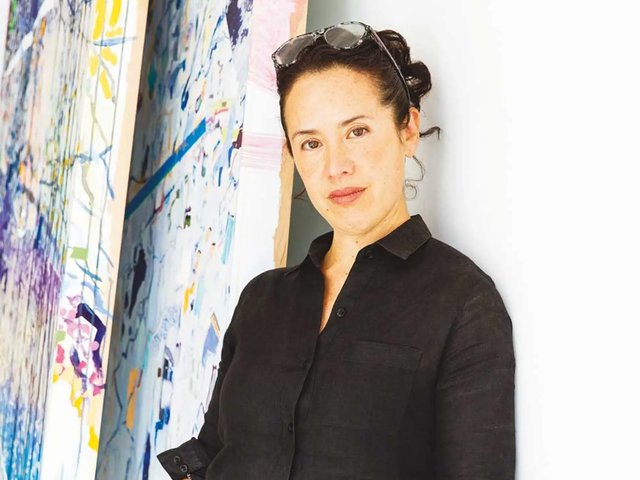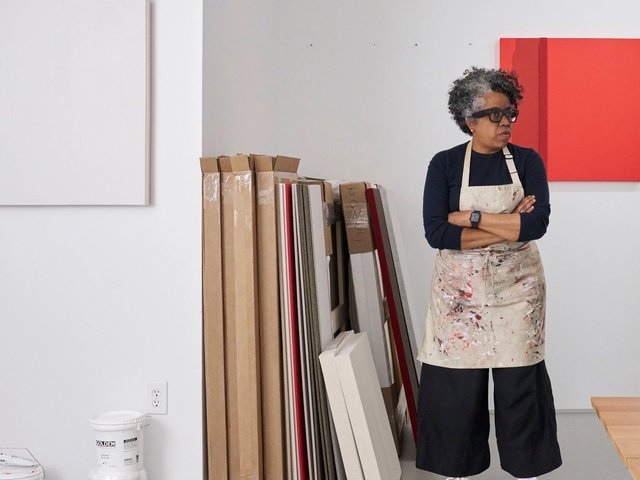Nanette Carter may have been making abstract art since the 1970s, but her work has never felt more urgent. Carter's elegant, off-kilter forms articulate the alienating experience of life in the thick of political turmoil, drawing on references as disparate as jazz and Russian Constructivism to convey the uniquely see-sawing circumstances of today.
Her upcoming solo exhibition Nanette Carter: Afro Sentinels, set to open at the Ohio State University's Wexner Center for the Arts on 22 August, constitutes a homecoming for Carter, who was born in Columbus, Ohio, in 1956. Her father, Matthew G. Carter, was a renowned civil rights leader who later became the first African American mayor of Montclair, New Jersey—she was first exposed to art through a childhood painting class at the Montclair Art Museum. This early encounter inspired her studies in studio art at Oberlin College in Ohio and the Pratt Institute in Brooklyn, where she went on to serve as a professor of art and coordinator of drawing for its undergraduate programme for 20 years. This homegrown legacy of big ideas and justice-oriented community has grounded Carter's practice throughout her career, imbuing her collages, paintings and sculptures with the warmth and immediacy of Black subjectivity.
Since the 1990s, Carter has been using Mylar, an industrial polyester material known for its tensile transparency, to pursue her experiments in form and colour. She regularly works in series, and the titles of her suites—Cantilevered, The Weight, Shifting Perspectives—suggest a subtle taste for subversion, the knowledge that certainty itself is fleeting and fantastical. Her pieces operate as discrete pursuits of balance. The notion of the show's titular "Afro Sentinels", imagined protectors of Black interest and sovereignty, bespeaks a yearning for security in a world besieged by what Carter calls a collective "lack of civility", defined by mundane violence and concerted, state-sanctioned destruction. Carter describes this pursuit of providing a counterweight as a concern with "the drama of nature in tandem with the drama of human nature", a simultaneous respite from and reminder of reality's bracing, beautiful severity.
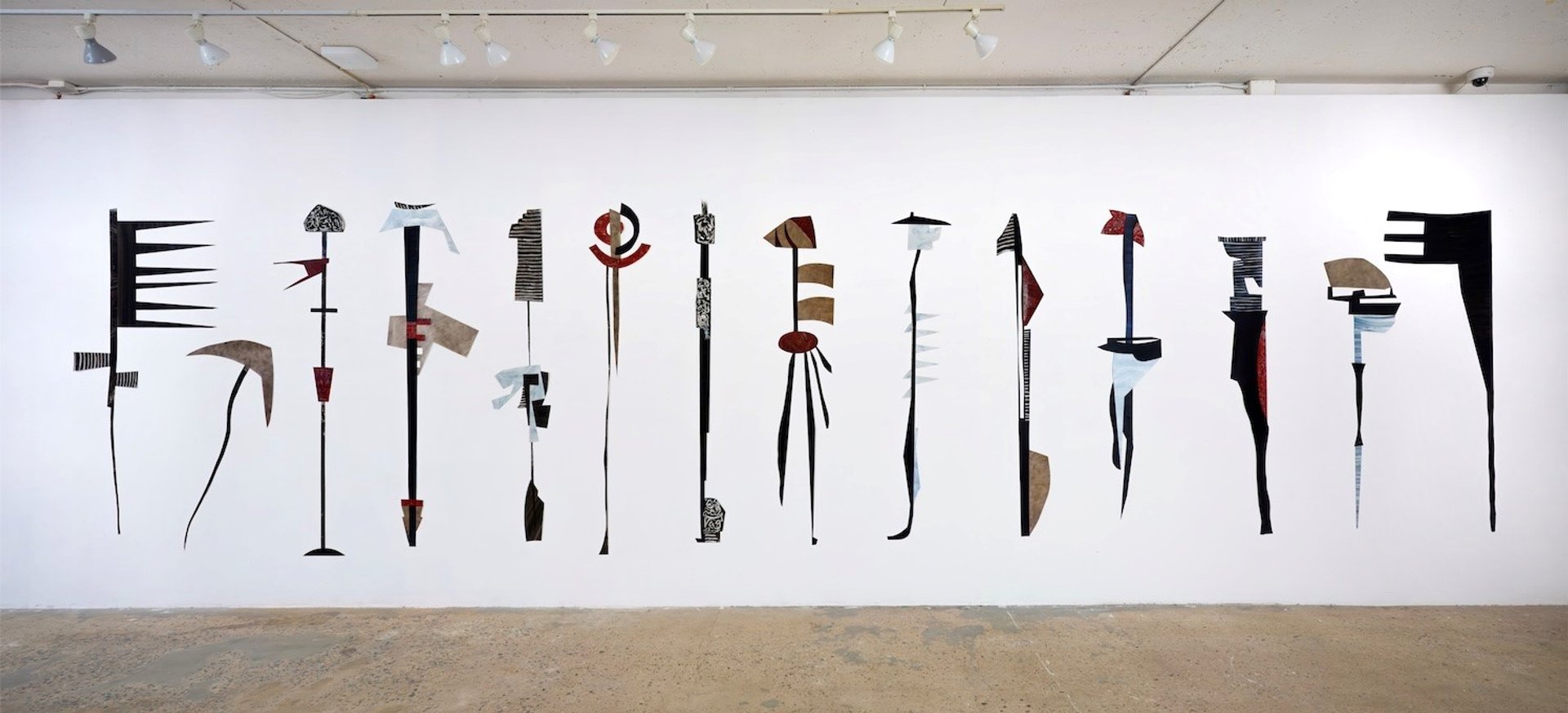
Nanette Carter, Afro Sentinels III, 2024 Courtesy of Berry Campbell, New York
In addition to a selection of recent works, Afro Sentinels will feature a new, three-dimensional commission by Carter, taking her work off the wall. This new approach "speaks to the seismic changes we have experienced over the last decade", says Carter, "whether we are looking at climate change [or] a global pandemic, it has been a most destabilising time". The Art Newspaper recently caught up with Nanette Carter to talk chaos, friendship, and the importance of education.
The Art Newspaper: Could talk a little bit about moving from two-dimensional to three-dimensional work for this commission, and what some of your structural and artistic concerns were?
Nanette Carter: I've been considering coming off the wall now for decades. Originally it was really about mixed media, mixed materials. I was thinking of bringing plastic, wood and metal together. I do have my favourites. I love David Smith's metal. I love Anthony Caro's metal. I love Calder. So I've been looking at folks, but I decided, because this is my first foray into this, to stick to one material. I decided metal.
And I have to say, it's been a confluence of things that have happened that really have set the tone for me to do this right now, at this moment. One was getting this wonderful commission from the Wexner. I just thought—this is the time! Then I was introduced to an outfit over in the Navy Yard about a year ago and it was like, "Okay, this is it." I have this series, it's called Afro Sentinels, and in my head, at first, I thought, "Wow, let's just do some really tall sentinels." So all of this sort of came together. I have a fabulous welder. I am not doing the welding, although I have before!
Those pieces were done at Triangle Workshop, which was one of these wonderful residencies back in the 1990s that was actually partially run by Anthony Caro in upstate New York. But I did relief pieces. They weren't totally off the wall, but they were coming off the wall a bit. So working now and really having to consider the viewer walking around the piece, so that every angle is now of importance—it's quite exciting and a challenge. I love challenges. I think it's really what keeps me going in this art world. I've set a challenge by working with Mylar even, where I'm working and putting it directly on the wall. I love to venture into new areas and this is what this is for me. The process is also quite intriguing, so it all just came together.
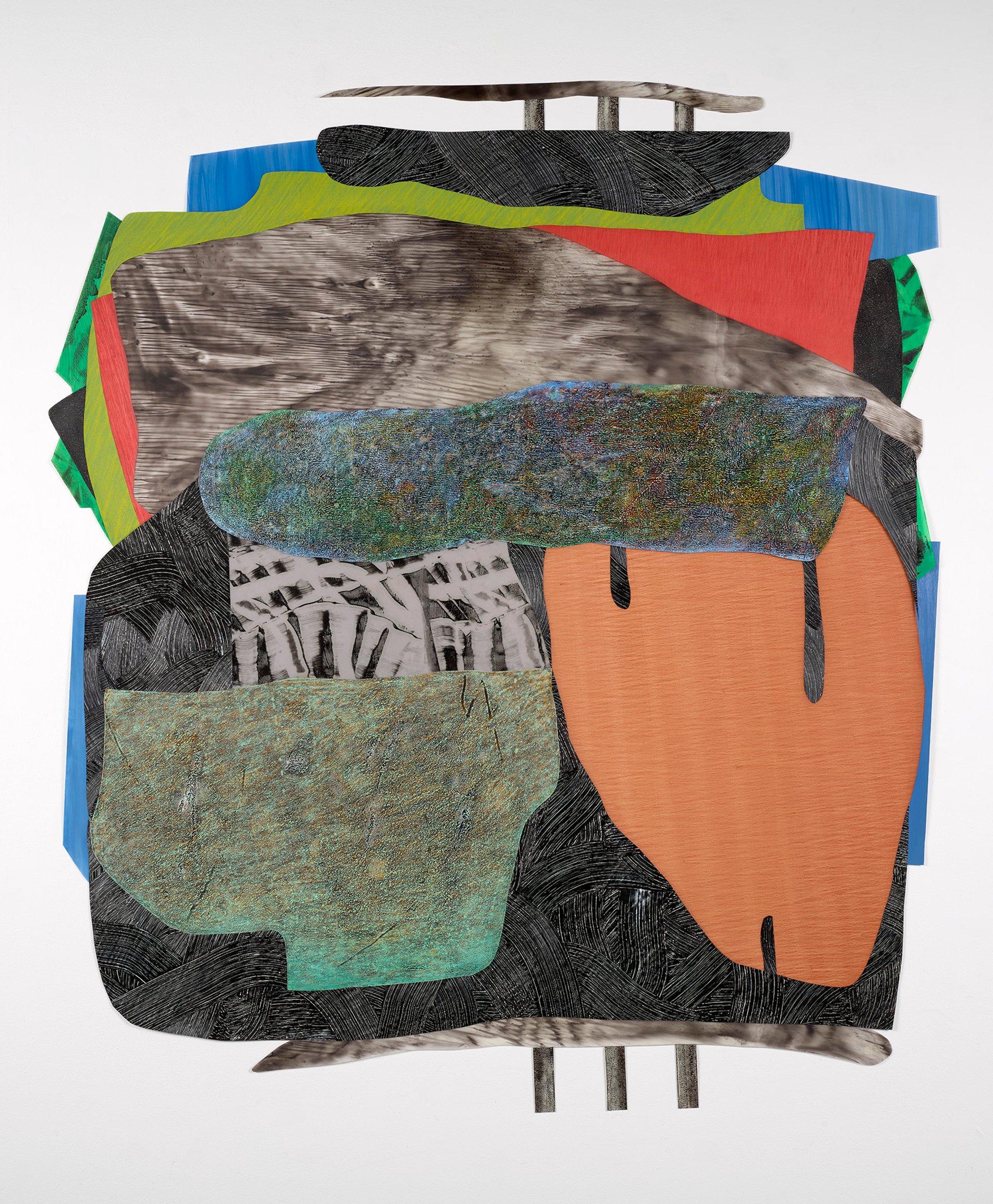
Nanette Carter, Cantilevered on Stilts, 2015 Courtesy of Berry Campbell, New York
What did you learn about the development of your practice as you put together work for this exhibition and your show at the Montclair Art Museum, Nanette Carter: Shifting Perspectives (until 10 August)?
Mary Birmingham curated the show at the Montclair Art Museum, my first museum retrospective, and working with her for really almost three years on this exhibition, pulling out old pieces from high school, it was just, "Wow!" I went to this fabulous school, Montclair High, which was amazing in terms of the art programme. We were doing etchings and painting with oil. We had a press. We had a dark room. We had a kiln and we had two wheels. We were doing ceramics. So to have that kind of programme in a public school was pretty amazing. And if you wanted to major in art, you could actually have classes every day just like you would have for math or science. So to have that kind of programme and then also to have my own studio in my home where I was also creating was incredible.
We pulled out some old drawings and one old fairly large painting for that show. One of the things that really came to light for me was I was always a bit of a rebel. I've always wanted to do something a little unique and different from what everyone else was doing. Most of the time when you set up a still life, everyone puts that still life dead center on the page. I didn't do it—I set it off to the side. Maybe the cast shadow might be what would be the rest of the image, but I would always crop things a little uniquely. Form was really a big, a major player even back in my early days. I noticed a couple of times where cast shadows didn't have gradations of the value as the shadow went off into the distance. It would all be a solid black. So that form was really pronounced. So things like that; I could see where it originated and I can see where I was really trying to be unique and creative. I've always been influenced by other artists who have been pushing the boundaries, and I have enjoyed seeing them and then thinking to myself, "Yeah, these are challenges that I want to take on also." I used to tell my students this all the time, especially when I taught at Pratt because they're going to have these solo shows at the end of their studies there: "Go into that space and sit and just really take in everything, really begin to look to see what are the moves you need to make moving forward."
We have around 48 pieces in the show, and that was very hard. Mary had a difficult time. I've been on this earth for a while. I'm 71, and I've been working in making art since elementary school. I always knew I was gonna be an artist. But I think that she got the key pieces that helped to tell the story of trying to challenge myself and trying to be different.
How is your current work engaging with the political moment?
My father was in politics. He was the mayor of Montclair, and he was a town commissioner also. Growing up in the Civil Rights movement, the 1950s and 60s, the dinner table conversation many times was about what was going on in this country. Even when my parents would have guests over for dinner, and we entertained quite a bit especially when my father was mayor, the conversation always turned to politics.
We always had so many periodicals coming into the house too. Back then you had so many magazines—Time, Life, Ebony Magazine, Jet Magazine, The New York Times, The Star Ledger, The Crisis, which was a periodical started by W.E.B. DuBois. All of this was coming to the house and and although as a young person I might not have been reading it all, I saw the photos, I heard the conversation at the dinner table. And so this idea of of documenting our time, which is what artists do, was also something that I thought about. I can bring these two areas together, my art and my concern, and now my concerns involve the globe. It's not just about people of colour but also the globe in terms of climate change, immigration—this whole idea of trying to live one's life in the fullest, as we all want to do.
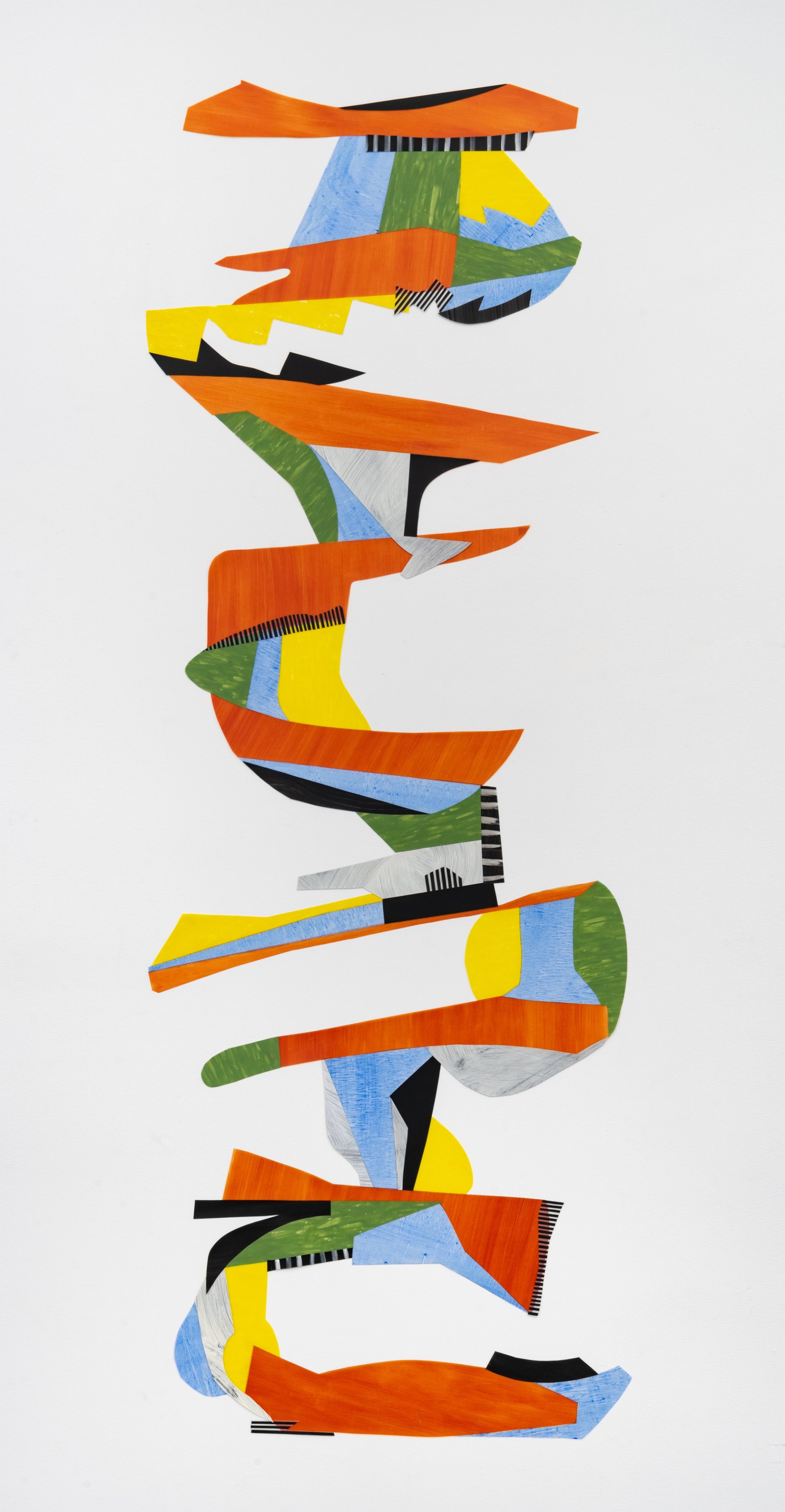
Nanette Carter, Shifting Perspectives, 2024 Courtesy of Berry Campbell, New York
Has your visual language evolved over time to articulate these themes of resistance and instability?
I feel that abstract art is universal because it's not talking about a particular place. It's not talking about a particular people even. It's not talking about, for instance, a particular landscape. It's really open for everyone to come in and with their imagination, with their experiences, bring different things to light. With something that I've made, I might be thinking one way about it, but someone else comes with heir experiences and their knowledge and they see something else and that's good. There's nothing wrong with that. I like to call it universal. Abstractions are universal. That semiotic opens it up and broadens it.
Because of my forms and the way that I've structured the forms, I think many times one can see what my themes are about. For instance, the series Cantilevered, which has 63 works in the series, reflects this idea of living in the 21st century with so much going on. I think social media and streaming has opened up things to people. We're not just looking at news from CBS and NBC, we're looking at news from all over the world—Al Jazeera, what have you. It's this broadening of things. It's very exciting, but it's a lot to take. We're seeing news as it happens—balancing all of this, or not being able to balance it. And some of the pieces in the Cantilevered series are called Cantilevered Teetering. Some of them you can actually see where things are about to roll off or they have rolled off, because you gotta let go of some of the stuff, too.
Cantilevered was this wonderful metaphor, trying to deal with all of these things that are going on, and this is worldwide. This is not just the United States. We saw people all over the world come out against the war in Gaza or in support of Black Lives Matter. Again, this is global. The work really can speak globally also just because I am dealing with these forms, which can sometimes allude to the body or to people, and that's fine. But I think the structure and the fact that in that series there is clearly a plinth, a bottom structure that's holding up the form and then these arm-like areas—people can read what's happening. I like that tension. I love the tension of piling things up like that, too.
I have another series, it's called Shifting Perspectives, and that one I really was dealing with this Trump era, and it truly is the era of Trump. I think it's a backlash from Obama, I do. Eight years of a Black president where there was no craziness going on and mayhem and what have you. But Shifting Perspectives comments on the fact that this country is moving very fast into a lack of empathy. Some conservatives are saying there's been too much empathy and that the liberals are all about empathy and and that that's not good. Then there are others that are saying that the MAGA folks have no empathy, it's all about oneself.
Series are clearly an important part of your practice. What is it about iteration that interests you?
I've never had a situation where I'm not dealing with one series at a time. Now I'm working on four different series at once just because of the times that we're living in. I like to work in a series. I have these ideas and then there are so many ways that I need to flush that out. Then something happens to me inside when I know it's over and I need to move on to another idea. So there's Destabilizing, that's a series; there's Shifting Perspectives. I'm done with Cantilevered, that's over.
But now I have The Group. The Group is really about these women who are my friends, and we've been together for 35 years. The the eldest is 83, and the youngest is about 62, 63. And we've weathered through all of this, and we've been together during Covid. We would dress up and put on makeup and have our cocktails together on Zoom. Whatever we needed to do to hold each other up, we've done. That's about these different characters who are my friends and have been my friends. And they are characters!
- Nanette Carter: Afro Sentinels, 22 August-11 January 2026, Wexner Center for the Arts, Columbus, Ohio
- Nanette Carter: Shifting Perspectives, until 10 August, Montclair Art Museum, Montclair, New Jersey





